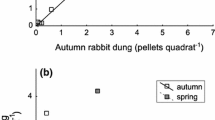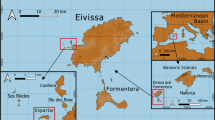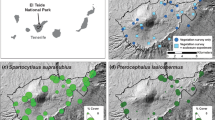Abstract
Subantarctic tall tussock grassland and megaherb vegetation has been massively affected by feral herbivores on islands where both occur. The effects of rabbits in this vegetation on Macquarie Island were monitored using 66 permanent quadrats and numerous photo-points on the steep coastal slopes of the island from 1980 to 2007. Vegetation change after landslips was also monitored. At the start of this period rabbit numbers plummeted due to the introduction of myxoma virus, but then increased from the late 1990s. Over the years of reduced rabbit numbers, some recovery of tall tussock grassland took place. With the resurgence in rabbit numbers, successional patterns converged towards a uniform pattern of degraded vegetation with more bare ground. The patterns of vegetation change indicate that recovery of the vegetation, after eradication of rabbits, rats and mice, is likely to be rapid where degradation is recent and where seed sources are in close proximity. The exotic plant species currently on the island are unlikely to present a problem.



Similar content being viewed by others
References
Ashton DH (1965) Regeneration pattern of Poa foliosa Hook. f. on Macquarie Island. Proc Roy Soc Vict 79:215–233
Australian Government Publishing Service (AGPS) (1993) Census of Australian vascular plants. Australian Flora and Fauna Series, vol 11. AGPS, Canberra
Bergstrom DM, Chown SL (1999) Life at the front: history, ecology and change on southern ocean islands. TREE 14:472–477
Bergstrom DM, Turner PAM, Scott J, Copson G, Shaw J (2006) Restricted plant species on subantarctic Macquarie and Heard Islands. Polar Biol 29:532–539
Brothers NP, Copson GR (1988) Macquarie Island flora and fauna management—interpreting progress and predictions for the future. Pap Proc R Soc Tasm 122:129–135
Chapuis J-L, Frenot Y, Lebouvier M. (2004) Recovery of native plant communities after eradication of rabbits from the subantarctic Kerguelen Islands, and influence of climate change. Biol Conserv 117:167–179
Cooke BD, Chapuis J-L, Magnet V, Lucas A., Kovaliski J (2004) Potential use of myxoma virus and rabbit haemorrhagic disease virus to control feral rabbits in the Kerguelen Archipelago. Wildl Res 31:415–420
Copson GR (1984) An annotated atlas of the vascular flora of Macquarie Island. ANARE Research Notes 18, Antarctic Division, Department of Science and Technology, Australia
Copson GR, Brothers NP, Skira I.J (1981) Distribution and abundance of the rabbit, Oryctolagus cuniculus (L.) at subantarctic Macquarie Island. Aust Wildl Res 8:597–611
Copson GR, Whinam J (1998) Response of vegetation on subantarctic Macquarie Island to reduced rabbit grazing. Aust J Bot 46:15–24
Copson GR, Whinam J (2001) Review of ecological restoration programme on subantarctic Macquarie Island: Pest management progress and future directions. Ecol Manag Rest 2:129–138
Costin AB, Moore DM (1960) The effects of rabbit grazing on the grasslands of Macquarie Island. J Ecol 48:729–732
Costin AB, Wimbush DJ (1961) Studies in catchment hydrology in the Australian Alps. IV. Interception by trees of rain, cloud and fog. Division of Plant Industry CSIRO, Technical Paper No. 16
Frenot Y, Gloaguen JC, Trehen P (1997) Climate change in Kerguelen Islands and colonization of recently deglaciated areas by Poa kerguelensis and P. annua. In: Battaglia B, Valencia J, Walton DWH (eds) Antarctic communities: species, structure and survival. Cambridge University Press, Cambridge, pp 358–366
Frenot Y, Chown SL, Whinam J, Selkirk PM, Convey P, Skotnicki M, Bergstrom DM (2005) Biological invasions in the Antarctic: extent, impacts and implications. Biol Rev Camb Philos Soc 80:45–72
Jenkin JF (1975) Macquarie Island, Subantarctic. In: Rosswall T, Heal OW (eds) Structure and function of tundra ecosystems. Ecol Bull (Stockholm) 20:375–397
Jones TD, McCue KF (1988) The seismicity and tectonics of the Macquarie Ridge. Pap Proc R Soc Tasm 122:51–57
Kirkpatrick JB, Scott JJ (2002) Change in undisturbed vegetation on the coastal slopes of subantarctic Macquarie Island, 1980–1995. Arct Ant Alp Res 34:300–307
Minchin P (1991) DECODA user manual. Anutech, Canberra
Misiak W (1998) The soil seedbank and standing vegetation of six communities on subantarctic Macquarie Island. Unpublished Honours thesis, University of Queensland, Australia
Parks and Wildlife Service (2006) Macquarie Island Nature Reserve and World Heritage Area Management Plan. Parks and Wildlife Service, Department of Tourism, Arts and the Environment, Hobart, Tasmania. http://www.parks.tas.gov.au/publications/tech/macquarie/macquarie.pdf (accessed 1/4/07)
Parks and Wildlife Service and Biodiversity Conservation Branch (PWS and BCB) (2007) Plan for the eradication of rabbits and rodents on subantarctic Macquarie Island. Parks and Wildlife Service, Department of Tourism, Arts and the Environment, Tasmania, and Biodiversity Conservation Branch, Department of Primary Industries and Water, Tasmania. March 2007, pp 1–30. http://www.environment.gov.au/heritage/publications/draft-macquarie-rabbit-eradication-plan.html (accessed 1/4/07)
Scott JJ (1985) Effects of feral rabbits on the revegetation of disturbed coastal slope sites, Macquarie Island. Unpublished Master of Arts thesis, Monash University, Melbourne, Australia
Scott JJ (1988) Rabbit distribution history and related land disturbance, Macquarie Island. Pap Proc R Soc Tasm 122:255–263
Scott JJ (1995) Changes in vegetation on Macquarie Island coastal slopes, 1980–1990. Unpublished PhD Thesis, University of Tasmania, Hobart, Australia
Scott JJ, Kirkpatrick JB (2005) Changes in subantarctic Heard Island vegetation at sites occupied by Poa annua, 1987–2000. Arct Ant Alp Res 37:366–371
Selkirk JM (1996) Peat slides on subantarctic Macquarie Island. Zeit Geomorph 105:61–72
Selkirk PM, Costin AB, Seppelt RD, Scott JJ (1983) Rabbits, vegetation and erosion on Macquarie Island. Proc Linn Soc NSW 106:337–346
Selkirk PM, Seppelt RD, Selkirk DR (1990) Subantarctic Macquarie Island: environment and biology. Cambridge University Press, Cambridge
Shaw J (2005) The reproductive ecology of vascular plants on subantarctic Macquarie Island. Unpublished PhD Thesis, University of Tasmania, Hobart, Australia
Smith VR (2002) Climatic change in the subantarctic: an illustration from Marion Island. Clim Change 52:345–357
Springer K (2006) Macquarie Island—mammalian pests past, present and future. Aliens 23:14–17. Newsletter of the Invasive Species Specialist Group of the IUCN Species Survival Commission
Taylor BW (1955) The flora, vegetation and soils of Macquarie Island. Antarctic Division, Department of Science and Technology, Australia, ANARE Rep., Ser B (2):19
Tweedie CE, Bergstrom DM (2000) A climate change scenario for surface air temperatures at Sub-Antarctic Macquarie Island. In: Davison W, Howard-Williams C, Broady P (eds) Antarctic ecosystems: models for wider understanding. New Zealand natural science. Canterbury University, Christchurch, pp 272–281
Whinam J, Copson GR (2006) Sphagnum moss: an indicator of climate change in the sub-Antarctic. Pol Rec 42:43–49
Acknowledgments
We thank the Tasmanian Parks and Wildlife Service for permission to visit the island, and the Australian Antarctic Division for project and logistic support, and for funding assistance under ASAC Project 2317, over the many years of visits for this project. Thanks to those who helped JJS in the field on various occasions and discussed at length the issues of rabbits and vegetation; to all the Parks rangers who have taken part in the photo-monitoring work; to Rowan Trebilco for allowing us to analyse his set of offshore coastal images of the southwest coast; and to Justine Shaw, Keith Springer and Ian Houshold for helpful comments on drafts of this paper. Many thanks to the referees; Maj de Poorter provided useful comment from a conservation perspective, and two anonymous referees gave perceptive and valuable comment on the analyses and other aspects.
Author information
Authors and Affiliations
Corresponding author
Rights and permissions
About this article
Cite this article
Scott, J.J., Kirkpatrick, J.B. Rabbits, landslips and vegetation change on the coastal slopes of subantarctic Macquarie Island, 1980–2007: implications for management. Polar Biol 31, 409–419 (2008). https://doi.org/10.1007/s00300-007-0367-y
Received:
Revised:
Accepted:
Published:
Issue Date:
DOI: https://doi.org/10.1007/s00300-007-0367-y




